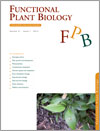
Functional Plant Biology
Volume 41 Number 1 2014
FP13117Root growth and N dynamics in response to multi-year experimental warming, summer drought and elevated CO2 in a mixed heathland-grass ecosystem
Ecosystems exposed to elevated CO2 are often found to sequester more atmospheric carbon due to increased plant growth. We show that a heathland–grass ecosystem increases root growth when exposed to elevated CO2. The nitrogen uptake did not increase similarly but the higher root production might lead to long-term increased N uptake on a whole-plant basis.
FP13047Making the best of the worst of times: traits underlying combined shade and drought tolerance of Ruscus aculeatus and Ruscus microglossum (Asparagaceae)
Shrubs in the genus Ruscus have flat, photosynthetic stems that are similar in appearance to leaves: these species are adapted to tolerate combined shade and drought. The aim of this work was to clarify the mechanisms that enable Ruscus to occupy extremely low resource understory sites. We studied 57 traits of two species, Ruscus aculeatus and R. microglossum, and considering their unique adaptations and trait values, Ruscus can serve as a model for how plants can avoid a general trade-off between shade and drought tolerance.
FP12316Partitioning hydraulic resistance in Sorghum bicolor leaves reveals unique correlations with stomatal conductance during drought
Drought reduces the production and yield of plants worldwide, but the mechanisms that control the variable responses of plants to water limitation is still not fully understood. Among six genotypes of Sorghum bicolor we show that the hydraulic resistance of different leaf tissues correlates with stomatal conductance at different levels of drought severity. These results help explain the variability in plant responses to drought, and reveals fundamental relationships between leaf hydraulic conductance and plant water-use strategies.
FP13033The role of leaf hydraulic conductance dynamics on the timing of leaf senescence
Despite their importance in plant nutrient redistribution, the mechanisms controlling the onset of leaf senescence are poorly understood. A reduction of leaf hydraulic conductance with age influences leaf senescence in tomato, but not in tropical and temperate trees. Although reductions of transpiration rates affected leaf longevity in tomato and one tropical tree species, hydraulic regulation of the xylem-transported compounds apparently acted as an age-dependent signal controlling leaf senescence in tomato.
FP13033 Abstract | FP13033 Full Text | FP13033PDF (565 KB) | FP13033Supplementary Material (1019 KB)
FP13086A phenotypic marker for quantifying heat stress impact during microsporogenesis in rice (Oryza sativa L.)
Heat stress at gametogenesis in rice causes significant reduction in spikelet fertility. Currently, there is no marker available for precise phenotyping of this trait. The inter collar distance of –8 to –9 cm between the immediate fully opened leaf and the flag leaf is an effective phenotypic marker to estimate heat stress induced damage at gametogenesis. This finding will drive breeding efforts to develop heat tolerance during gametogenesis in rice.
FP13140Understanding the molecular events underpinning cultivar differences in the physiological performance and heat tolerance of cotton (Gossypium hirsutum)
Daily exposure to temperatures above an optimum, as well as heat waves, reduces plant growth, development and ultimately yield. Development of heat resistant plants may improve crop yields in hot environments. By identifying genes and gene pathways involved in the heat stress response, this research shows key areas that can be targeted to breed cotton varieties with heat tolerance to improve yields in warm and hot environments.
FP13126Development and evaluation of a field-based high-throughput phenotyping platform
The limited availability of tools for rapidly and reliably measuring plant traits under relevant conditions has impeded progress in crop improvement. We developed and evaluated a tractor-based system that can measure traits related to the heat and drought stress tolerance of field-grown plants throughout the growing season. The system has the potential to increase the quantity and quality of field trait data, facilitating the development of high yielding stress-tolerant crops.
FP13050Molecular cloning and characterisation of an acyl carrier protein thioesterase gene (CocoFatB1) expressed in the endosperm of coconut (Cocos nucifera) and its heterologous expression in Nicotiana tabacum to engineer the accumulation of different fatty acids
The mechanisms by which coconut endosperm accumulates medium chain fatty acids (≈60%) are still unknown. In this paper, an acyl- acyl carrier protein thioesterase (CocoFatB1) was isolated form coconut and heterologously expressed in transgenic tobacco. The results indicated that CocoFatB1 acts specifically on 14 : 0-ACP, 16 : 0-ACP and 18 : 0-ACP, and can increase medium chain saturated fatty acid in transgenic plants.
FP13005Control of glycerol biosynthesis under high salt stress in Arabidopsis
Loss-of-function and gain-of-function approaches were utilised to detect the physiological influence of glycerol biosynthesis during salt stress and the role of glycerol in conferring salt tolerance in Arabidopsis. Results indicate the participation of glycerol overproduction in salt tolerance in Arabidopsis. Furthermore, we hypothesise that mechanism(s) of glycerol retention/efflux in the cell are affected at 200 mM NaCl in Arabidopsis.
FP13085Negative short-term salt effects on the soybean–Bradyrhizobium japonicum interaction and partial reversion by calcium addition
The soybean–rhizobia symbiotic interaction is severely affected by salt stress. We analysed the short-term salt stress effects on soybean root hair ionic homeostasis, PR gene expression and its effect on nodulation. Short exposure to salt affected root hair ionic homeostasis and PR protein gene expression, and reduced the nodule number. The addition of calcium is a common agricultural practice to reverse salt effects. We report a positive effect of calcium addition on soybean nodulation under saline conditions.



